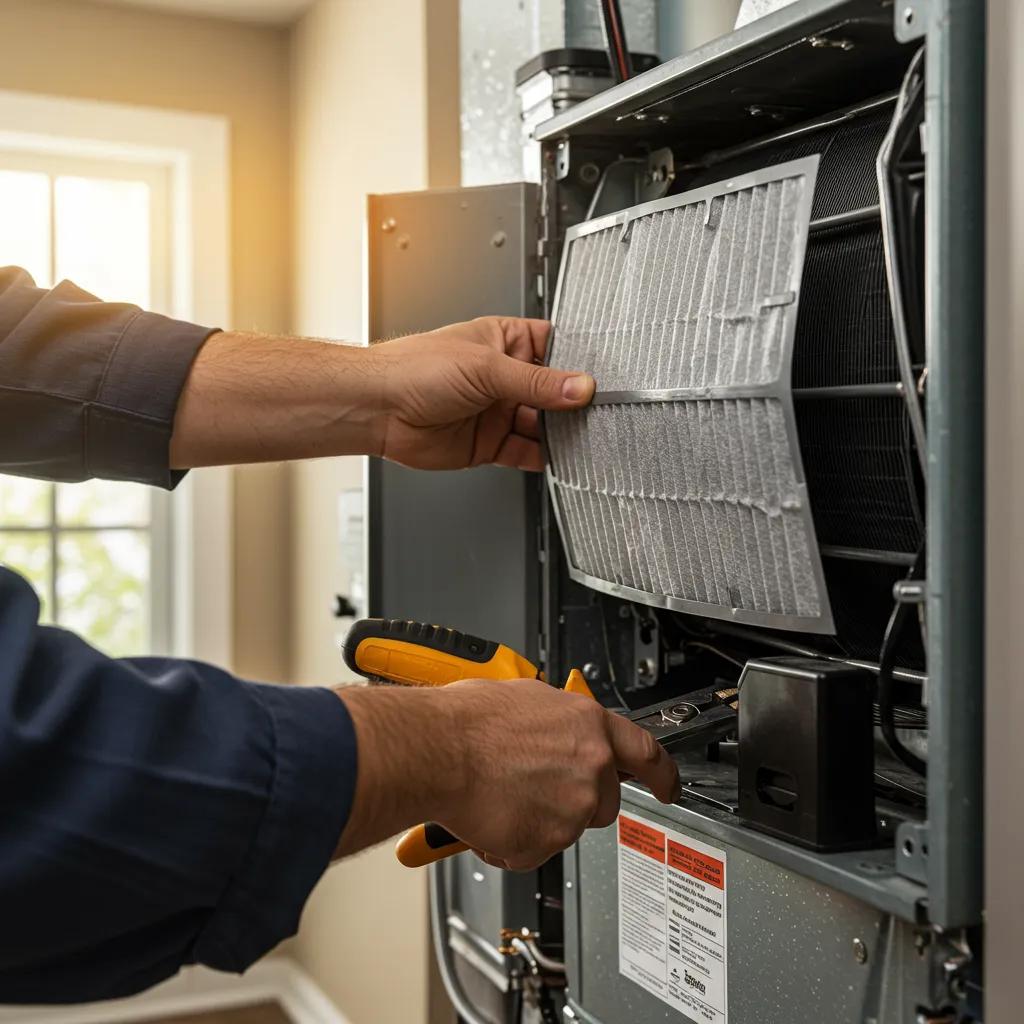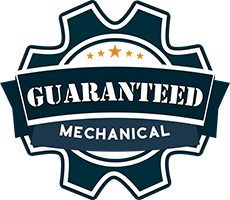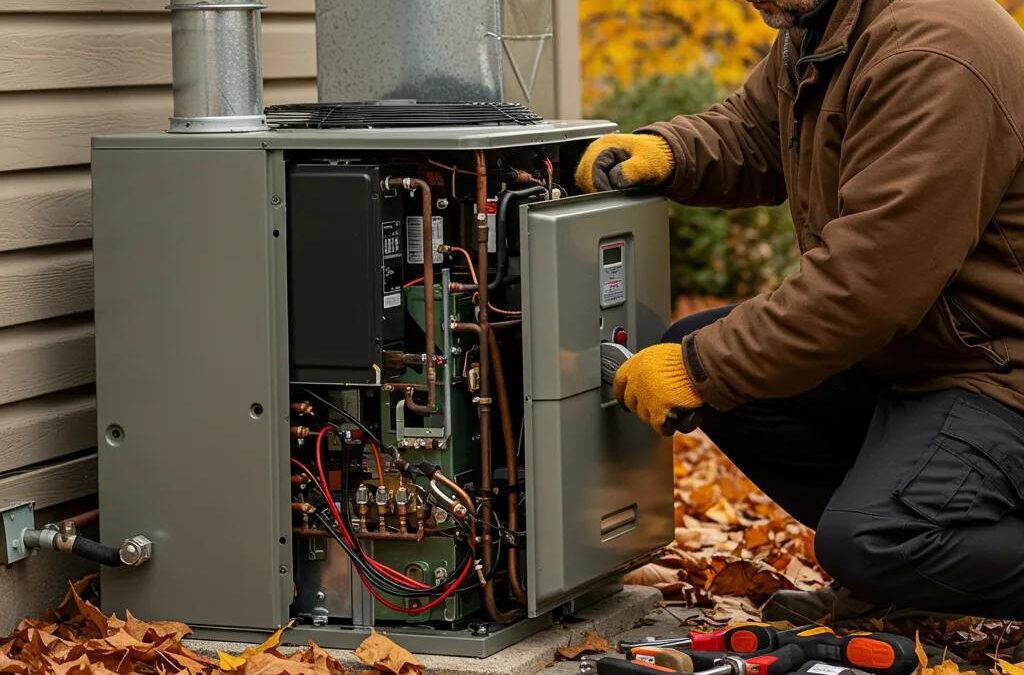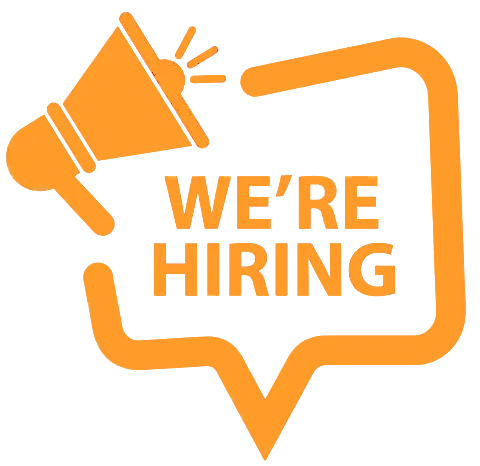Get Your HVAC Ready for Fall: A Complete Guide for Homes and Businesses
Keeping your heating, ventilation, and air conditioning system in top shape as autumn rolls in helps prevent unexpected breakdowns, makes your system more energy-efficient, and extends its lifespan.
In Aurora, IL, and the western suburbs of Chicago, as temperatures drop and heating needs rise, a thorough fall HVAC check-up is a must for both homeowners and businesses.
This guide covers the most important tasks—from swapping out filters and fine-tuning your thermostat to cleaning coils and performing safety checks. We’ve broken it down into four key areas: getting your home furnace ready for fall, preparing your business’s system, boosting energy efficiency, and simple DIY tips. Plus, we’ll show you why teaming up with Guaranteed Mechanical, with our skilled team and trusted Amana products, means you’ll get dependable performance, honest advice, and 24/7 emergency help.
What Are the Must-Do Fall Furnace Tune-Up Tasks for Homeowners?

A fall furnace tune-up is your annual chance to inspect, clean, and optimize your system for safe and efficient heating. At Guaranteed Mechanical, our HVAC system maintenance plans use expert diagnostics on every part, helping to lower your energy bills and reduce the risk of carbon monoxide issues. Key tasks include changing the air filter, adjusting the thermostat, preparing the outdoor unit, testing carbon monoxide detectors, and scheduling a professional inspection.
Here’s a quick checklist of essential fall tune-up tasks for your home furnace:
- Swap out and check your air filters.
- Calibrate and program your thermostat.
- Clear away any debris around your outdoor unit.
- Test your carbon monoxide detectors.
- Book a professional furnace tune-up.
Completing these steps will help ensure your home stays comfortable and safe all winter long, and it sets the stage for more in-depth system checks.
How Do You Change and Check Air Filters in the Fall?
Replacing and inspecting your air filters is a fundamental step that directly impacts airflow, the quality of your indoor air, and how efficiently your heating system runs. Here’s how to do it safely and correctly:
- Turn off your furnace at the power switch.
- Open the filter access panel and carefully slide out the old filter.
- Check the filter size and MERV rating to make sure it matches what your manufacturer recommends.
- Install a new filter, making sure the airflow arrow points towards the furnace.
- Close the access panel securely and turn the power back on.
Changing filters every 1–3 months helps trap dust and allergens, prevents your motor from working too hard, and keeps your ductwork cleaner. This simple task is a great starting point for optimizing your thermostat and other system care.
Why Is Fine-Tuning Your Thermostat Important for Colder Weather?
Optimizing your thermostat means adjusting its settings to keep your home at a consistent temperature while using less energy. Modern digital and smart thermostats can learn your household’s routines, minimize unnecessary heating cycles, and boost comfort. By setting back the temperature when no one’s home and pre-heating rooms before you use them, you can cut your heating bills by up to 15 percent. Proper calibration ensures accurate temperature readings and prevents your furnace from running too often, which helps your equipment last longer and keeps humidity levels balanced throughout the fall.
What Steps Should You Take to Prepare Your Outdoor HVAC Unit for Autumn?
Preparing your outdoor unit involves clearing away obstructions and protecting its components from frost. Start by gently removing leaves, twigs, and other yard debris from around the condenser unit. Make sure the unit is level and secure any loose panels or covers. You can use a breathable, weather-resistant cover for vulnerable controls, but be sure not to seal in moisture. Finally, check the refrigerant lines to ensure their insulation is intact and repair any damaged jackets. This routine helps prevent rust, protects the coils from freezing damage, and ensures efficient refrigerant flow until spring.
How Do You Test Carbon Monoxide Detectors During Fall Maintenance?
Testing your carbon monoxide detectors is a crucial safety step that goes hand-in-hand with your furnace tune-up. Press and hold the test button on each detector for five seconds to ensure it sounds the alarm, and remember to replace the batteries at least once a year. Check the detector housings for dust buildup and make sure they are placed near sleeping areas and the furnace room. Confirming your detectors are working before the heating season starts is vital for preventing dangerous exposure and complements checks on your furnace’s burner and heat exchanger.
When Is the Best Time to Schedule a Professional Furnace Tune-Up?
Experts recommend scheduling your professional furnace tune-up in early autumn, ideally before the temperature consistently drops below 50°F (10°C). Getting service early in the season means you can secure your preferred appointment time, allow for thorough inspections of the burner and heat exchanger, and have any minor repairs done before the peak heating demand hits. Guaranteed Mechanical’s preventive maintenance plans include detailed diagnostics, component lubrication, and safety testing to ensure your furnace is ready for the entire cold season.
Which Commercial HVAC Fall Maintenance Tasks Help Avoid Costly Breakdowns?
Commercial HVAC systems need specialized autumn maintenance to minimize downtime, manage operating costs, and meet building codes. Essential tasks include cleaning coils, checking refrigerant levels, calibrating control systems, and using predictive maintenance to spot potential issues early. Businesses that follow structured maintenance plans can avoid unexpected failures and keep their occupants productive.
Here’s a comparison of key commercial HVAC components and how fall maintenance impacts them: HVAC preventative maintenance quality
| Component | Maintenance Task | Benefit |
|---|---|---|
| Evaporator Coil | Professional cleaning and sanitizing | Restored heat exchange efficiency |
| Refrigerant Lines | Pressure and leak checks | Prevents energy loss and system strain |
| Control Panels | Software updates and calibration | Ensures precise temperature control |
| Condensate Drains | Clearing and treatment | Avoids water damage and microbial growth |
Proactive fall maintenance for commercial systems reduces repair expenses, extends equipment life, and maintains high indoor air quality standards, helping businesses transition smoothly into winter operations.
What Are the Key Coil Cleaning and Refrigerant Checks for Businesses?
Cleaning coils removes dust, oil residue, and microbial film from the evaporator and condenser coils, which restores heat transfer efficiency and reduces the workload on the compressor. Technicians use special foaming agents and gentle rinses to avoid damaging the coils. Refrigerant checks involve verifying pressure readings against manufacturer specs, using electronic sensors to find leaks, and topping up refrigerant levels if needed. These steps prevent a drop in system capacity, lower operating costs, and reduce the risk of the compressor failing prematurely.
How Does Predictive Maintenance Help Prevent Commercial HVAC Failures?
Predictive maintenance uses IoT sensors and data analysis to anticipate component wear and tear before breakdowns happen. Real-time monitoring of vibrations, temperature differences, and refrigerant pressures triggers alerts when anomalies are detected. This data-driven approach allows technicians to make repairs during scheduled maintenance, avoiding emergency calls and maximizing system uptime. Over 60 percent of modern commercial buildings that use predictive strategies report a 30 percent decrease in maintenance costs.
Why Are Preventative Maintenance Contracts Crucial for Commercial HVAC?
Preventative maintenance contracts outline scheduled inspections, component servicing, and emergency response terms in a cost-controlled agreement. These contracts guarantee priority access to skilled technicians, predictable budgeting for HVAC expenses, and documented compliance with safety regulations. By scheduling annual fall and spring tune-ups, businesses can benefit from extended equipment warranties and a lower risk of costly mid-winter outages.
How Can Smart Thermostats and Variable-Speed Systems Boost Energy Efficiency?
Smart thermostats optimize temperature settings and operating times based on occupancy and weather forecasts, leading to energy savings of up to 20 percent. Variable-speed compressors and fans adjust their output to precisely match the heating or cooling demand, eliminating inefficient on/off cycles. When integrated with building automation systems, these technologies coordinate heating, cooling, and ventilation schedules to minimize peak demand charges and improve occupant comfort.
How Does Fall HVAC Maintenance Improve Energy Efficiency and System Longevity?
Fall maintenance ensures your HVAC components work together optimally by removing obstructions to heat transfer, fine-tuning control settings, and verifying safety features. This process leads to significant benefits like lower energy use, fewer repair needs, and a longer service life by reducing wear and tear on motors and heat exchangers.
| Benefit | Mechanism | Value |
|---|---|---|
| Energy Savings | Reduced blower and compressor workload | Up to 15% lower heating bills |
| Extended Equipment Life | Lubricated bearings and clean coils | 2–3 additional operational years |
| Enhanced Air Quality | Fresh filters and duct inspections | Reduced allergens and microbial growth |
| Improved Safety | Verified carbon monoxide and flame sensor | Minimised fire and poisoning hazards |
What Energy Savings Can Homeowners Expect from Fall HVAC Tune-Ups?
Homeowners can typically expect to see a 10–20 percent reduction in heating bills after a fall tune-up, thanks to improved airflow, calibrated thermostats, and clean heat exchangers. Removing debris and replacing filters can lower the blower motor’s energy consumption by up to 10 percent, while precise adjustments to the fuel-to-air ratio optimize furnace combustion. These efficiencies can lead to average annual savings of $300–$500, depending on local energy prices and how much you use your system.
How Does Regular Maintenance Extend HVAC System Lifespan?
Routine inspections and lubrication help prevent premature failure of motors, bearings, and heat exchangers. By clearing condensate lines and cleaning coils, technicians prevent corrosion and microbial growth that can damage metal surfaces. Consistent maintenance interrupts the wear cycle, protects the compressor, and reduces the chance of breakdowns during the busiest heating periods. Systems that are well-maintained often last several years longer than their expected lifespan.
Why Is Indoor Air Quality Improved by Autumn HVAC Care?
Cleaning or replacing air filters, vacuuming duct interiors, and sanitizing coils remove dust, pollen, and microbial contaminants from the air circulating in your home. Balanced airflow prevents stagnant areas where mold can grow, and sealed ductwork reduces the entry of outdoor pollutants. Better indoor air quality supports respiratory health and makes your home more comfortable, especially as you close windows and your heating system circulates air more frequently.
How Does Fall Maintenance Ensure Safety in Homes and Businesses?
Safety checks during fall maintenance include testing carbon monoxide detectors, inspecting gas lines for leaks, and assessing the integrity of flues and vents. Ensuring the flame sensor is responsive and the heat exchanger seals are intact prevents combustion gases from escaping into occupied spaces. These procedures create an essential safety net against fire risks and toxic gas exposure.
What DIY Fall HVAC Maintenance Tips Can Homeowners Safely Do?
Empowering homeowners to handle basic fall HVAC tasks helps ensure their system is ready and can extend the time between professional service calls. Simple jobs like clearing debris, changing filters, inspecting vents, and sealing windows can improve heating efficiency without needing special tools.
How to Clear Debris and Seal Windows for Better Heating Efficiency?
Clearing leaves and mulch away from your outdoor unit prevents coils from getting blocked and restricts airflow. Homeowners should trim back any vegetation at least 12 inches from the equipment housing. To improve indoor efficiency, check the seals on your windows and doors, apply weather-stripping, and caulk any gaps around the frames. These actions reduce cold air infiltration, allowing your furnace to maintain your desired temperature using less energy.
What Are Simple Air Filter Replacement Steps for Fall?
To replace a standard disposable filter:
- Find the filter compartment on your furnace or air handler.
- Slide out the old filter, noting the direction of the airflow arrow.
- Insert a new filter of the correct size and MERV rating.
- Secure the compartment and jot down the replacement date for your next reminder.
How to Inspect Vents and Ductwork for Fall Readiness?
Check your supply and return vents for dust buildup or blockages. Remove the vent covers and vacuum the inside surfaces using a soft brush attachment. Inspect visible duct joints for any gaps or loose connections and seal them with heat-resistant foil tape. Well-sealed ductwork minimizes heat loss and ensures balanced airflow throughout your home.
When Should You Contact a Professional for Complex HVAC Issues?
Homeowners should seek expert help if they notice any of the following:
- Strange noises coming from the burner or fan.
- Consistently low airflow, even with clean filters.
- Thermostat readings that fluctuate or the system short-cycles.
- A corroded heat exchanger or visible gas leaks.
Why Choose Guaranteed Mechanical for Your Fall HVAC Maintenance in Aurora, IL and Chicago’s Western Suburbs?
Guaranteed Mechanical is a family-owned, local HVAC specialist with generations of experience serving Aurora and the surrounding suburbs. We combine honest recommendations, Amana-approved equipment, and a team with over 15 years of average tenure to provide reliable, friendly fall tune-ups and emergency support. Our comprehensive maintenance plans include preventive inspections, clear cost estimates, and priority scheduling for your critical fall and winter service needs.
How Does Our Experienced Workforce Ensure Reliable Fall HVAC Service?
Technicians with extensive experience use precise diagnostic methods during every fall inspection. Their deep understanding of regional climate challenges and various equipment models allows them to make targeted adjustments that maximize efficiency and safety. This level of expertise leads to consistent results and builds lasting trust with homeowners and businesses.
How Do Our Honest Recommendations Save You Money and Improve Safety?
Guaranteed Mechanical objectively assesses your system’s condition and recommends only necessary repairs or replacements. By focusing on your actual needs rather than pushing unnecessary upgrades, we help you avoid extra costs and ensure you receive installations and services that truly enhance your comfort and safety.
What Emergency Services Are Available During Fall and Winter?
Our emergency response teams are available around the clock to handle heating failures, gas leaks, and critical safety alerts. Our rapid-response protocols and fully stocked service vehicles ensure quick on-site diagnosis and repair, protecting your home or business throughout the coldest months.
How Should Businesses Prepare Their HVAC Systems for Winter After Fall Maintenance?
Winterizing your system after a tune-up involves specific checks for heat pumps, drainage systems, and control integrations. This phase ensures that refrigeration components are protected from freezing, condensate lines stay clear, and automated controls switch smoothly between heating and economizer modes.
What Are Best Practices for Heat Pump and Drainage System Checks?
Inspect heat pump reversing valves to ensure they are properly lubricated and check defrost cycles under ambient test conditions. Flush condensate drains with a biodegradable cleaning solution to break down organic buildup. Verifying the correct slope and clear lines prevents water backups that can lead to coils freezing and microbial growth.
How Can Building Automation Systems Support HVAC Winter Readiness?
Integrating fall maintenance data with building automation platforms allows for adaptive scheduling, alerts for detected faults, and remote adjustments to settings. Automated start-stop sequences based on real-time temperature and airflow data reduce the need for manual oversight and immediately flag any deviations from optimal settings.
What Regulations Should Commercial Properties Consider for Fall HVAC Compliance?
Commercial properties must adhere to local energy codes, indoor air quality standards, and refrigerant management regulations. Fall inspections should include confirmation of filter MERV ratings, refrigerant leak reporting procedures, and documentation of annual safety tests to meet the requirements of regulatory bodies and insurance providers.
What Are the Most Important Safety Checks During Fall HVAC Maintenance?
Safety checks are a critical part of autumn tune-ups, covering carbon monoxide risk prevention, the integrity of burners and heat exchangers, and strategies to avoid emergency failures. These inspections protect occupants and equipment while ensuring your heating system works without interruption.
How to Detect and Prevent Carbon Monoxide Risks in Fall?
Visually inspecting heat exchanger seams and vent connectors can reveal cracks or loose joints that might allow combustion gases to enter living spaces. Pressure testing gas lines and cleaning flame sensors ensure complete fuel combustion. Following these steps protects your indoor air and helps your detectors function accurately.
Why Is Furnace Burner and Heat Exchanger Inspection Essential?
Furnace burners should produce an even, blue flame for efficient combustion; any yellow tipping indicates incomplete burning and soot production. Inspecting the heat exchanger for hairline fractures is crucial, as these pose fire and poisoning risks. Thorough cleaning and crack testing prevent system failures and safeguard occupant health.
How Does Fall Maintenance Help Avoid Emergency HVAC Failures?
By addressing minor issues—like worn belts, low refrigerant levels, and clogged drains—during scheduled fall service appointments, technicians can prevent sudden breakdowns when your system is under heavy winter use. This approach to risk management minimizes business downtime, reduces the cost of emergency repairs, and provides greater peace of mind.
Making sure your HVAC system is ready for fall involves a mix of simple DIY tasks and professional tune-ups that offer real savings, extend your equipment’s life, and ensure your safety. With our comprehensive maintenance plans, expert technicians, and trusted Amana products, preparing for autumn becomes a smart investment in lasting comfort and reliability.




Recent Comments